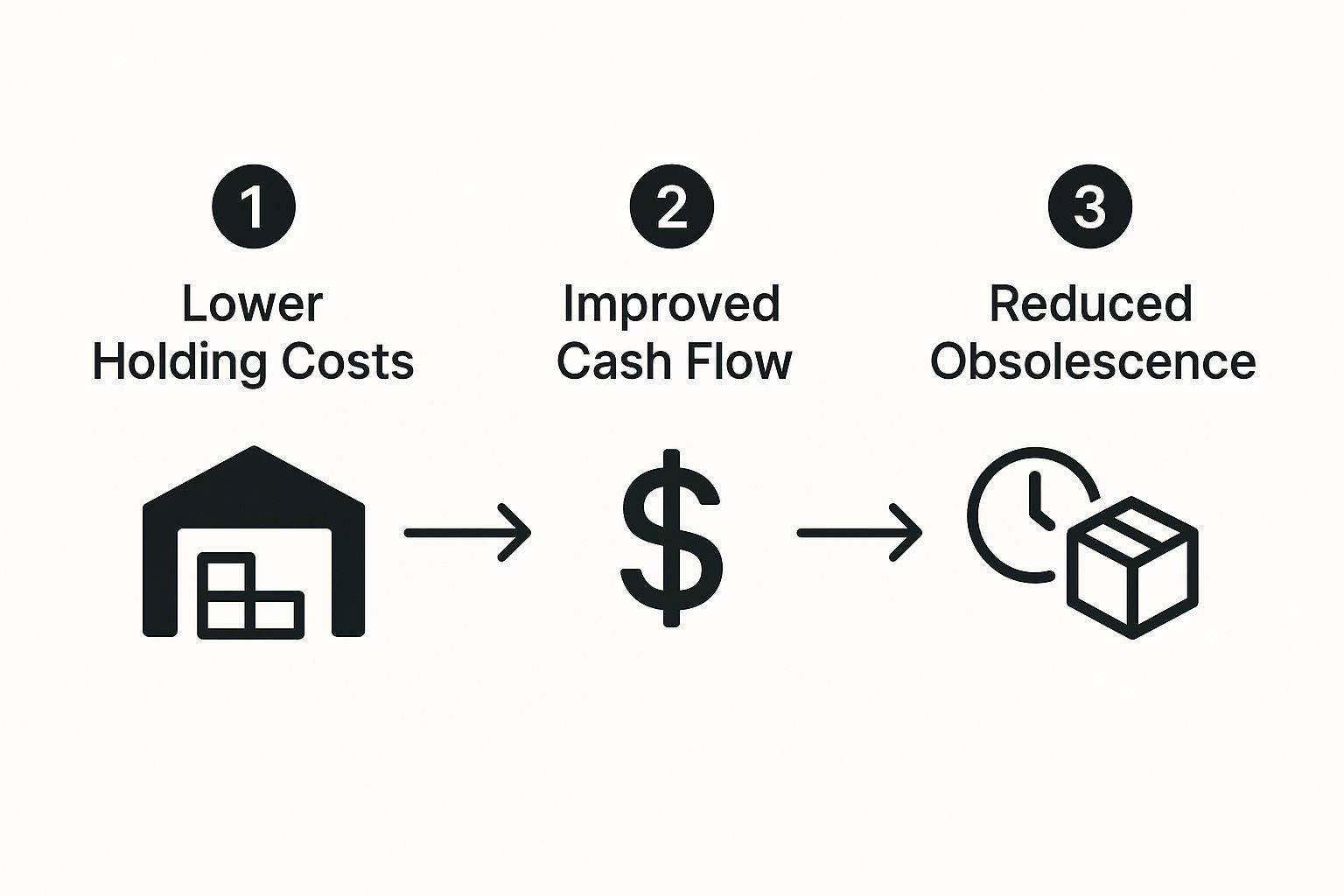Arthur Lynch | Mon Sep 15 2025
Using an Inventory Turnover Ratio Calculator to Maximize Profit
Are you looking at trays of unsold necklaces while the pieces you just got in are flying off the shelves? That’s a classic, and frustrating, inventory problem. The best tool you have for figuring this out is an inventory turnover ratio calculator. It tells you, in plain numbers, exactly how fast you're turning your stock into cash, providing actionable insights to boost your jewelry business.
Why Inventory Turnover Is Your Most Important Metric
Think of your inventory turnover ratio as more than just an accounting term—it's the strategic compass for your entire jewelry business. This one metric shows you how many times you sell and replace your inventory over a certain period, like a quarter or a year.
A healthy ratio is a sign you're efficiently selling what you buy. It means your capital isn't just sitting there, trapped in a display case full of slow-moving items. For any jewelry retailer, getting a handle on this metric is the absolute key to profitability and long-term growth.
Knowing this number helps you make much smarter buying decisions. It shines a spotlight on which pieces are truly connecting with your customers and which ones are just collecting dust. That insight is non-negotiable when you start planning for major sales events, like the 2025 end of year holiday season.
Preparing for Holiday Success
As you gear up for the holidays, your turnover data is your best friend. Look back at your performance to see which styles, metals, and price points were your big winners. This lets you stock up with confidence on high-turnover pieces from wholesalers like JewelryBuyDirect, while being a lot more cautious with new or unproven trends.
A high turnover ratio is a clear signal of strong sales and smart inventory management. It frees up your cash flow, giving you the agility to react to shifting jewelry trends and invest in the pieces your customers actually want to buy.
Decoding Fashion Trends for Your Store
Staying ahead of the curve means keeping an eye on both global and regional jewelry fashion trends. For example, minimalist gold chains might be a bestseller globally, but perhaps your local market has a sudden passion for bold, colorful enamel rings from Europe or artisan-inspired silver from Southeast Asia. Analyzing your turnover by category helps you catch these subtle but crucial differences.
Here's how to turn this data into an actionable inventory plan when working with a wholesaler:
- Pinpoint Your Core Bestsellers: These are the high-turnover staples you can always count on. Ensure you have deep stock from reliable sources so you don't run out during the busiest times.
- Test Emerging Global & Regional Trends: Dedicate a smaller part of your buying budget to pieces that reflect current global and local fashion movements. Watch their turnover data closely to quickly decide if a trend is a hit with your customers and worth reordering.
Finding the Right Numbers for Your Calculation

Any calculation is only as good as the numbers you feed it. As the old saying goes, garbage in, garbage out. So, let’s walk through exactly where to find the two key ingredients you'll need for an accurate inventory turnover ratio: your Cost of Goods Sold (COGS) and your Average Inventory.
Getting this right is critical. One of the most common mistakes I see jewelry retailers make is using the retail price of their items instead of the cost. That one small error can dramatically skew your results and lead you to make some really poor buying decisions. Always, always use the actual cost you paid for the inventory.
Locating Your Cost of Goods Sold (COGS)
First up is COGS. This number represents the direct cost of all the jewelry you sold over a specific period—say, a year or a quarter.
If you're using accounting software like QuickBooks or Xero, this is pretty easy. Just pull up your income statement (sometimes called a profit and loss statement), and you'll find COGS listed right there.
For those still tracking things manually, the formula is simple:
Beginning Inventory + Purchases - Ending Inventory = COGS
This calculation tells you the cost of the specific pieces that actually walked out the door with a customer.
Calculating Your Average Inventory
Next, you'll need to figure out your average inventory for that same period. Using an average is important because it smooths out the natural peaks and valleys in your stock levels, like when a big wholesale order lands or you have a major holiday sell-down.
Here’s the formula:
(Beginning Inventory Value + Ending Inventory Value) / 2 = Average Inventory
Again, remember to use the cost value of your inventory, not what you hope to sell it for. This number gives you a realistic picture of how much capital you typically have tied up in stock.
For example, let's say you started the year with $40,000 in inventory and ended it with $60,000. Your average inventory for the year would be $50,000. That's the figure you'll use.
Nailing these inputs is non-negotiable for smart purchasing. When you know your true COGS and how quickly specific items turn, you can better evaluate which of the best wholesale jewelry suppliers are actually making you the most money. With clean data, you move from guessing to making strategic, profitable decisions.
Putting the Inventory Turnover Ratio to Work
Alright, now that you have your Cost of Goods Sold (COGS) and Average Inventory figures, we can get to the good part. The math itself is simple, but the real magic happens when you see what this number reveals about your jewelry business.
The inventory turnover ratio is a fantastic health check for your business. It tells you exactly how many times you’ve sold through your entire stock and replaced it within a certain timeframe. The formula is pretty straightforward: Cost of Goods Sold (COGS) ÷ Average Inventory.
So, if a retailer has a COGS of $800,000 and their average inventory is valued at $200,000, their ratio is 4. Simple as that. This means they sold and restocked their inventory four times over that period.
Let’s Walk Through a Real-World Example
Imagine you run an online jewelry boutique. You’re looking back at your numbers for the 2025 holiday rush to plan for next year.
First, you need to pull two key numbers for that quarter (October 1 to December 31):
- Cost of Goods Sold (COGS): You calculate that all the sterling silver rings and necklaces sold during Q4 cost you a total of $15,000.
-
Average Inventory: You started the quarter with $20,000 worth of stock (at cost). By the end of the holiday frenzy, you were left with $10,000 in inventory.
- To find the average, you'd calculate: ($20,000 + $10,000) / 2 = $15,000.
With those numbers ready, we can plug them into the formula:
$15,000 (COGS) / $15,000 (Average Inventory) = 1.0
A ratio of 1.0 tells you that you sold through your entire average inventory exactly one time during the holiday season. Knowing this helps you make smarter decisions about buying, pricing, and promotions. A healthy turnover ratio is a direct line to better financial health for your business.
When you nail this, you’ll see lower holding costs, much healthier cash flow, and far less risk of getting stuck with stock that’s gone out of style.

At the end of the day, a strong turnover ratio means you're efficiently turning your products into profit. This is a crucial piece of the puzzle when figuring out your overall profitability, which you can dig into further with our wholesale profit margin calculator.
What Your Turnover Ratio Is Actually Telling You

Okay, you've run the numbers through an inventory turnover ratio calculator and now you're staring at a figure. So what? This is the moment where a simple number becomes a powerful tool for your business strategy.
First, let’s get one thing straight: there’s no universal “good” ratio. The context of your jewelry business is everything. A boutique specializing in one-of-a-kind, high-karat diamond pieces will naturally move inventory much slower than a trendy shop selling affordable, fashion-forward jewelry that taps into the latest global styles.
Think of your ratio as a health check for your inventory. A low number often points to overstocking or specific items that just aren't selling, tying up precious cash that could be used elsewhere. Conversely, a sky-high ratio might feel great, but it could be a warning sign that you're understocked and constantly missing out on sales because your bestsellers are always gone.
From Diagnosis to Action Plan
The real value here is turning this insight into tangible, profit-driving actions. Your turnover ratio is a signpost, pointing you toward exactly what needs fixing in your stock management, especially when sourcing from wholesalers like JewelryBuyDirect.
If your ratio is on the low side, it’s time to get creative with the stock you already have. Some moves I’ve seen work wonders include:
- Smart Bundling: Got a slow-moving bracelet? Pair it with a hot-selling necklace in a special "set" promotion. This helps move the old inventory while riding the coattails of a winner.
- Strategic Flash Sales: Target specific categories with the lowest turnover for a limited-time discount. It's a great way to generate immediate cash flow and make room for new items.
- Informed Reordering: Use this data to be ruthless with your next wholesale order. Double down on what sells and be skeptical about reordering items that have proven to be duds.
Now, if your ratio is too high and you're constantly telling customers "we're sold out," your strategy needs a different focus. With the crucial 2025 end of year holiday season on the horizon, you can't afford to be out of stock.
- Beef Up Your Safety Stock: For your A-list items, order a little extra. This buffer is your insurance policy against a sudden surge in demand or a supplier delay.
- Dig Into Sales Velocity: Pinpoint which pieces fly off the shelves the fastest. Make sure your reordering process for these items is airtight to minimize the time they are unavailable.
To make this even clearer, here’s a quick guide to help you interpret your number and decide on your next steps.
Jewelry Inventory Turnover Ratio: What Your Number Means
| Turnover Ratio | What It Indicates | Potential Action Steps |
|---|---|---|
| Below 1.0 (Low) | Overstocked or Slow-Moving Items. Capital is trapped in unsold goods. Potential for outdated styles. | • Run targeted promotions or flash sales. • Bundle slow-movers with bestsellers. • Re-evaluate buying strategy; cut poor performers. |
| 1.0 to 2.5 (Healthy) | Good Balance. Inventory is selling efficiently without frequent stockouts. Strong cash flow. | • Continue monitoring sales trends. • Fine-tune reorder points. • Experiment with new product lines cautiously. |
| Above 2.5 (High) | Potential Understocking. You may be missing sales due to frequent stockouts of popular items. | • Increase order quantities for bestsellers. • Implement a safety stock for key products. • Analyze sales data to forecast demand better. |
Ultimately, this is about finding that sweet spot for your specific business—having just enough stock to satisfy your customers without letting your capital collect dust.
The goal isn't to obsess over a perfect number. It's about using the inventory turnover ratio as a compass to guide you toward a healthy balance. Nailing that balance is the secret to maximizing profit and building a jewelry business that lasts.
Using Your Data for 2025 End of Year Holiday Planning

For jewelry retailers, the holiday season is our Super Bowl. It’s the make-or-break period that can define the entire year. If you want to make sure the upcoming 2025 end of year holiday season is a roaring success, your inventory turnover data is your secret weapon. It’s time to stop guessing and let the numbers guide your buying strategy.
Just look back at last year's holiday rush. By digging into which specific categories had the highest turnover, you can start forecasting demand with some serious accuracy. Maybe you discover that your minimalist sterling silver chains turned over twice as fast as your chunky, gold-plated bracelets. That one piece of information is gold—it tells you exactly where to focus your purchasing power when you're placing your next wholesale order.
Balancing Timeless Staples with Trendy Must-Haves
A killer holiday inventory is all about striking the right balance. On one hand, you need your bread-and-butter staples. On the other, you need those exciting, on-trend pieces that create buzz. Your turnover data is what helps you nail this mix.
First, look at your high-turnover items from last year. These are your proven winners, the evergreen bestsellers you absolutely can't afford to run out of. Stock up on them confidently. At the same time, you must stay current by capturing emerging global and regional fashion trends.
- Global Trends for 2025: Keep an eye on major fashion weeks and publications. Early indicators point towards a continued interest in sustainable materials, bold mixed-metal designs, and personalized pieces like initial pendants.
- Regional Preferences: Is there a local love for turquoise in the Southwest US, or a preference for sleek, minimalist designs in Scandinavian-influenced urban areas? Tailor a portion of your inventory to these specific tastes.
When you do this, your historical data becomes more than just a report card—it becomes a predictive tool. You can build an inventory that doesn't just meet customer demand but actually anticipates it. This is a huge part of reducing procurement costs and making sure you capitalize on every single sale when it counts the most.
Preparing Your Orders with Wholesalers Like JewelryBuyDirect
Walking into a conversation with a wholesaler armed with this data changes everything. Instead of placing a vague order, you can confidently request specific quantities based on proven turnover rates from a partner like JewelryBuyDirect. It ensures every dollar you spend is on product that has a high likelihood of flying off the shelves.
Here is an actionable checklist for preparing your Q3/Q4 wholesale orders for the 2025 holiday rush:
- Analyze Last Year's Data: Identify your top 20% of items that drove 80% of your holiday sales. These are your must-stock items.
- Research 2025 Trends: Dedicate 15-20% of your budget to testing new trends. Look for styles gaining traction on social media and in fashion forecasts.
- Segment Your Order: Divide your purchase between core bestsellers, trend-focused pieces, and items catering to specific regional tastes.
- Discuss Lead Times: Confirm production and shipping timelines with your wholesaler to ensure inventory arrives well before the Black Friday rush.
By blending historical turnover analysis with real-time trend monitoring, you build an inventory that is both safe and exciting. This strategic approach minimizes the risk of overstocking on slow-movers while maximizing your potential for a blockbuster holiday season.
Common Questions About Inventory Turnover
https://www.youtube.com/embed/Ophz0_bkUAg
Even with a calculator, the inventory turnover ratio can bring up some tricky questions. It's a fantastic metric, but getting into the nitty-gritty of what it means for your business is what really helps you make smarter decisions. Let’s walk through some of the questions I hear most often from jewelry retailers, especially when the holidays are on the horizon.
One of the biggest anxieties is preparing for massive sales events like the 2025 end-of-year holiday season. Where do you even begin? Your own historical turnover data is, without a doubt, your most powerful tool. Look at which product categories flew off the shelves last year. Those insights should be the foundation for your new wholesale orders. Relying on your own sales history is always more dependable than just guessing at what's trendy.
Of course, you can't ignore what's happening in the wider world of fashion. While your turnover ratio tells you what has been popular with your customers, keeping an eye on global and regional trends helps you predict what will be. A truly balanced inventory strategy marries your proven bestsellers with a thoughtful selection of new, on-trend pieces.
Stocking Strategically with Wholesalers
When you're placing those crucial orders with a supplier like JewelryBuyDirect, it helps to break down your buying plan into a few key segments. This isn't just about managing risk; it's about making sure you have something for every type of customer.
-
Your Core Collection (70% of budget): This is your largest investment. These are your high-turnover workhorses—the classic gold hoops, simple silver chains, and birthstone pendants that you know will sell. They are the bedrock of your cash flow.
-
Trend-Focused Items (20% of budget): Set aside a smaller part of your budget to experiment with pieces that capture current global fashion movements, like chunky statement chains or vibrant enamel jewelry. Watch their turnover rates like a hawk; you might just discover your next bestseller.
-
Regional Favorites (10% of budget): Don't forget what makes your local market unique. If your customers love bold, artistic pieces, lean into that. Your inventory should always reflect the specific tastes of your community.
The best inventory strategy isn't just about stocking more; it's about stocking smarter. Use your turnover data to double down on what’s already working, and use that solid foundation to cautiously test new styles and capture emerging demand.
By blending your hard sales data with a forward-looking view of the market, you can feel confident that you’re carrying the right products at the right time. When you optimize your inventory with these kinds of practical insights, you’re setting your business up for a much more profitable and less stressful holiday rush.
Ready to turn your inventory into profit with confidence? JewelryBuyDirect provides direct-from-factory pricing and access to over 120,000 trend-driven styles, with no minimum order requirements. Explore our collection today and build a smarter, more profitable inventory.

 to show code
to show code






































































































































































